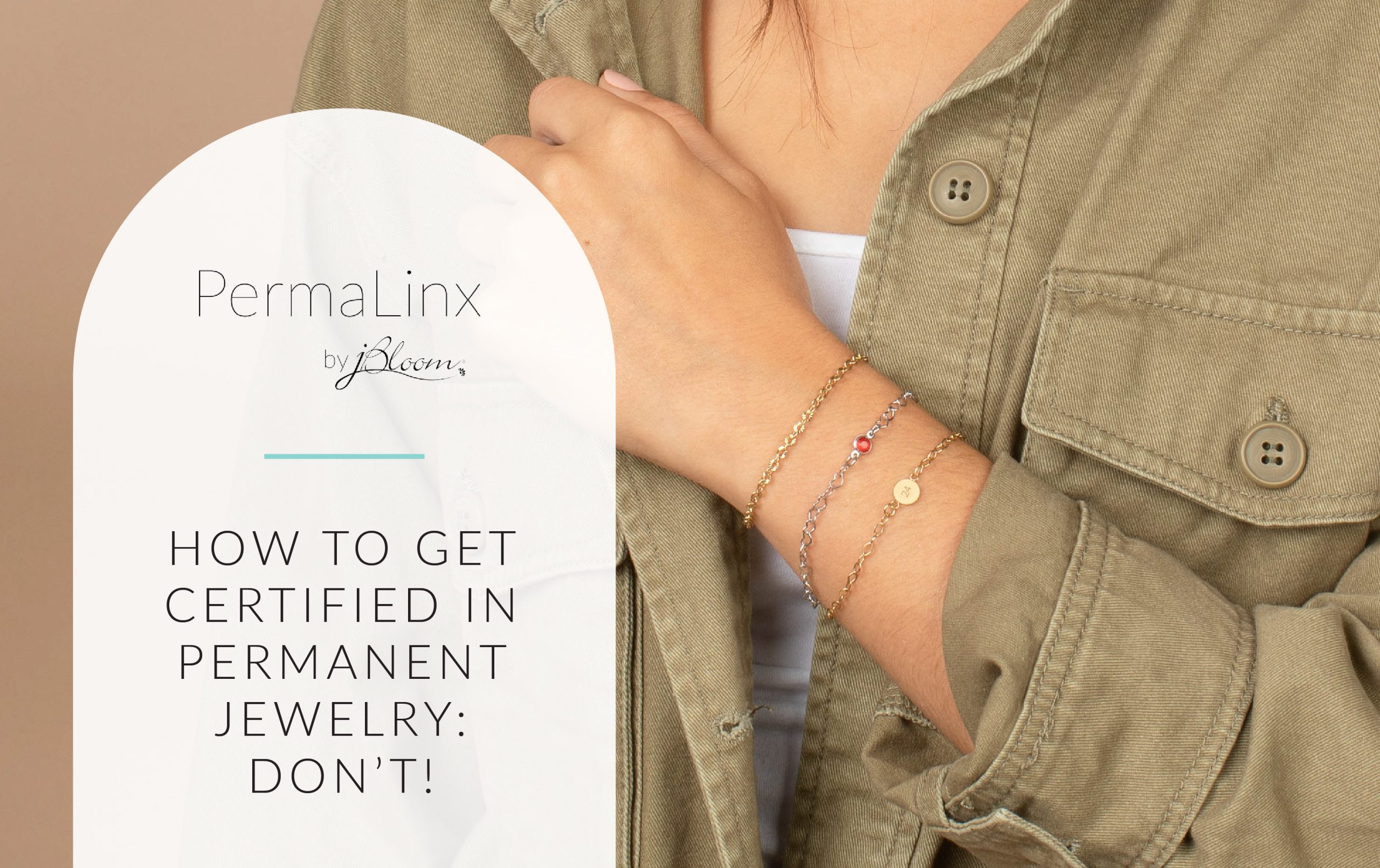To become a permanent jewelry artist, you need to master your craft, build a strong portfolio, and establish a solid client base. This profession requires dedication, continuous learning, and a unique creative vision in order to succeed.
Becoming a permanent jewelry artist involves more than just creating beautiful pieces. It requires determination, focus, and a willingness to continually hone your skills. By developing a signature style and consistently delivering high-quality work, you can establish yourself as a prominent figure in the jewelry industry.
Building a network of loyal clients and leveraging social media and online platforms can also help boost your visibility and secure long-term success. This comprehensive guide will provide insights and strategies to help you embark on a fulfilling journey as a permanent jewelry artist.

Credit: permanentjewelrycenter.com
Exploring Your Passion
Finding your passion is the first step towards becoming a permanent jewelry artist. It’s important to discover what truly ignites your creativity and excites you. When you are passionate about something, it becomes easier to dedicate time and effort to honing your skills and expanding your knowledge. In this section, we will explore two key aspects of exploring your passion: finding your unique style and studying different jewelry-making techniques.
Finding Your Unique Style
Developing a unique style in jewelry-making sets you apart as an artist and helps you create distinctive pieces that resonate with others. To find your unique style, consider the following:
- Experiment with different materials, such as beads, metals, or gemstones, to see which ones you feel most drawn to.
- Observe various jewelry designs and collections for inspiration, but avoid directly copying them. Instead, focus on understanding the elements that appeal to you and incorporating them into your own creations.
- Take note of the themes, colors, shapes, and patterns that regularly emerge in your designs. This will help you identify your signature aesthetic.
- Allow yourself to be open to exploration and change. Your style may evolve over time as you gain experience and inspiration from different sources.
Finding your unique style is a continuous journey, and it’s important to embrace the evolution and growth that comes with it. Don’t be afraid to experiment and break free from conventions to truly express your artistic vision.
Studying Different Jewelry-making Techniques
Building your expertise in various jewelry-making techniques broadens your skill set and allows you to explore different avenues of creativity. Here are some strategies to help you study different techniques:
- Enroll in jewelry-making classes or workshops to learn from experienced instructors who can guide you through different techniques and provide valuable insights.
- Seek inspiration from master jewelry artists by studying their works and understanding the techniques they use to achieve certain effects.
- Explore online resources, such as video tutorials and blogs, that offer step-by-step instructions for different jewelry-making techniques.
- Network with other jewelry artists and attend industry events to learn from their experiences and exchange knowledge.
Remember that mastering different techniques takes time and practice, so be patient with yourself. As you become proficient in various methods, you’ll have a wider range of tools to bring your creative ideas to life.

Credit: www.jbloomdesigns.com
Developing Essential Skills
Mastering Basic Metalworking Skills
In jewelry making, mastering basic metalworking skills is essential to create high-quality pieces.
- Learn how to shape and form metals using techniques such as filing, sawing, and soldering.
- Practice texturing metal surfaces to add depth and visual interest to your designs.
- Understand how to measure and cut metals accurately for precise jewelry construction.
Learning Stone Setting and Mounting Techniques
Stone setting and mounting techniques are crucial skills for jewelry artists who work with gemstones.
- Explore different stone setting styles like bezel, prong, and pave to enhance your designs.
- Practice proper stone setting to ensure stones are secure and aligned correctly in your jewelry pieces.
- Master mounting techniques to showcase gemstones effectively and create stunning finished products.
Also Read: How to Become a Bounty Hunter in Michigan
Building Your Portfolio
To become a permanent jewelry artist, focus on building a compelling portfolio showcasing your skills and creativity. Your portfolio is a visual representation of your work and plays a crucial role in attracting customers and opportunities.
Creating a Diverse Range of Jewelry Pieces
- Experiment with various materials, styles, and techniques.
- Showcase a mix of earrings, necklaces, bracelets, and rings.
- Create trendy pieces alongside timeless classics.
Photographing and Showcasing Your Work
- Invest in a good quality camera for clear, high-resolution images.
- Use natural light or a lightbox for optimal lighting.
- Highlight details and textures in your jewelry pieces.
- Create an online portfolio on your website or social media platforms.

Credit: blog.sunstonewelders.com
See Also: How to Become a Hells Angels Member
Understanding the Business Side
When it comes to becoming a permanent jewelry artist, it’s important to not only have a creative and artistic flair but also a deep understanding of the business side of things. This includes grasping pricing and costing strategies as well as establishing a brand and effectively marketing your jewelry.
Grasping Pricing and Costing Strategies
Pricing and costing your jewelry creations can be a daunting task, but it’s a crucial aspect of running a successful business. Properly pricing your pieces will help ensure that you not only cover your costs but also make a reasonable profit.
One effective pricing strategy is the “cost-plus” method, which involves calculating the total cost of materials, labor, overheads, and other expenses and adding an appropriate profit margin. This approach allows you to cover all your expenses and make a profit while still offering competitive prices to customers.
It’s also important to consider the market value of your pieces. Research the prices of similar jewelry in your niche to ensure that your pricing aligns with industry standards. Keep in mind that customer perceptions of value can also influence pricing, so focus on highlighting the unique aspects and craftsmanship of your jewelry.
Establishing a Brand and Marketing Your Jewelry
In today’s competitive jewelry market, establishing a strong brand identity is crucial for the success of your business. A well-defined brand helps differentiate your jewelry from others and allows you to connect with your target audience.
Start by clearly defining your brand’s values, mission, and unique selling proposition. Incorporate these elements into your website, social media profiles, packaging, and other marketing materials to create a cohesive and recognizable brand image.
When it comes to marketing your jewelry, leveraging the power of online platforms is essential. Create a professional website that showcases your designs and provides a seamless shopping experience for customers. Utilize search engine optimization techniques to increase your online visibility and attract potential customers.
In addition to your website, establish a strong presence on social media platforms such as Instagram, Facebook, and Pinterest. Regularly post high-quality images of your jewelry, engage with your audience, and build a community around your brand. Consider collaborating with influencers and participating in local events or pop-up shops to expand your reach.
Remember, effective marketing is an ongoing process. Continuously analyze and adapt your strategies based on customer feedback, market trends, and the results of your marketing campaigns.
Exploring Specialized Techniques
When it comes to becoming a permanent jewelry artist, it’s essential to explore specialized techniques that can elevate your craft to the next level. By mastering intricate methods such as filigree and granulation, and experimenting with enameling and patination, you can set yourself apart as a skilled and sought-after jewelry artist.
Mastering Filigree and Granulation
Filigree and granulation are ancient jewelry-making techniques that require precision and attention to detail. Filigree involves the intricate twisting and shaping of fine wires to create delicate patterns, while granulation involves fusing tiny metal beads onto a metal surface to form decorative motifs. Mastering these techniques can add a distinctive, ornate quality to your jewelry pieces.
Experimenting with Enameling and Patination
Enameling is the art of fusing powdered glass to metal through a high-temperature firing process, resulting in vibrant and durable designs. On the other hand, patination involves the controlled oxidation of metal to create unique surface colors and textures. Experimenting with these techniques allows you to add an array of colors, patterns, and visual interest to your jewelry creations.
Networking and Collaboration
Becoming a permanent jewelry artist requires more than just honing your craft; it also involves networking and collaboration with other artists and jewelers. By connecting with others in the industry and participating in exhibitions and workshops, you can develop valuable relationships, gain exposure, and expand your skill set. Let’s explore how networking and collaboration can propel your journey towards becoming a permanent jewelry artist.
Connecting with Other Artists and Jewelers
Building relationships with fellow artists and jewelers can open up new opportunities and provide fresh perspectives. Joining online communities or attending local meetups are great ways to connect with like-minded individuals. Take advantage of social media platforms to showcase your work and engage with other artists. Collaborating on projects or sharing resources can lead to mutual growth and valuable friendships.
Participating in Jewelry Exhibitions and Workshops
Attending and showcasing your work at jewelry exhibitions not only exposes your creations to a wider audience but also allows you to connect with potential customers and industry professionals. Participating in workshops provides the opportunity to learn new techniques, exchange ideas, and form fruitful partnerships. Keeping an eye out for local and international exhibitions and workshops can help you stay active in the jewelry community and stay updated with the latest trends and innovations.
Understanding Jewelry Trends
Keeping up with the latest jewelry trends is essential for any aspiring permanent jewelry artist. Understanding the market trends can help you create designs that resonate with customers and stand out from the competition. In this section, we will explore two key aspects of understanding jewelry trends: staying updated with market trends and adapting traditional techniques to modern styles.
Staying Updated with Market Trends
As a permanent jewelry artist, it’s crucial to stay in the loop with the latest market trends. By doing so, you can ensure your designs align with the current demands of consumers. Here are a few effective ways to stay updated:
- Follow fashion influencers and industry experts on social media platforms like Instagram and Pinterest.
- Attend jewelry expos, trade shows, and workshops to network with professionals and gain industry insights.
- Engage in online communities and forums dedicated to jewelry making, where you can discuss trends and exchange ideas with fellow artists.
By staying updated with market trends, you can discover new design styles, color palettes, materials, and techniques that are in high demand. This knowledge will enable you to create jewelry pieces that appeal to your target audience.
Adapting Traditional Techniques to Modern Styles
While keeping up with market trends is crucial, it’s equally important to preserve traditional jewelry-making techniques. While contemporary styles continue to evolve, there is a timeless appeal to traditional craftsmanship. By blending traditional techniques with modern styles, you can create unique and captivating jewelry pieces that reflect your artistic vision.
Here are a few ways to adapt traditional techniques to modern styles:
- Experiment with unconventional materials alongside traditional metals and gemstones to add a contemporary touch.
- Combine classic jewelry designs with minimalist aesthetics for a sleek and modern look.
- Integrate technology, such as 3D printing or laser cutting, into traditional methods to create intricate and innovative designs.
- Collaborate with other artists and designers to explore new perspectives and fusion of styles.
By adapting traditional techniques to modern styles, you can create jewelry pieces that blend heritage and innovation, appealing to a wide range of customers.
Establishing a Successful Jeweler’s Career
Start a Successful Journey into the World of Jewelry
Balancing Creativity with Commercial Viability
Developing creative designs that also cater to market demands is crucial.
Adopting Sustainable and Ethical Practices
Consider sourcing materials responsibly and practicing sustainable production methods.
Conclusion
In the ever-evolving world of jewelry artistry, becoming a permanent artist requires dedication, passion, and a strategic approach. By continuously improving your skills, building a strong portfolio, networking with industry professionals, and utilizing effective marketing techniques, you can establish yourself as a permanent jewelry artist.
Remember to consistently stay updated with the latest trends and techniques, and never let your creativity be limited. Combine your talent with perseverance, and great success in the jewelry industry awaits!
